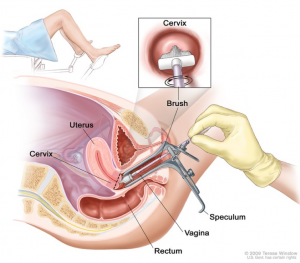HPV, or the Human Papillomavirus, is an important topic to understand in order to take control of your health. HPV infection is the main risk factor for cervical, vaginal and vulvar cancers. The Pap smear is the test used to screen for HPV and cervical cancer.
HPV comes in two general forms:
- the type that leads to genital warts and
- the type that leads to abnormal changes in the cells of the cervix.
Left untreated, the second form can lead to cervical cancer. Most people who have had intercourse have been exposed to HPV. However, most of the people who are exposed to HPV can clear the infection over time without needing to do anything. This is especially true in younger people exposed to HPV, because their immune systems are generally stronger. The risk of cervical dysplasia, or changes in the cells that could lead to cancer, varies depending on age and the strength of the immune system. Pap smears may need to be performed more frequently in some people who are at higher risk for developing cervical cancer.
Prevention
A Pap smear, the term for the test checking for cervical cancer, often gets confused with a pelvic examination. The Pap smear (see illustration below) is performed during a pelvic examination, but a pelvic exam is also performed for other reasons such as to assess for abnormal vaginal bleeding. You probably won’t get a Pap smear every time you have a pelvic examination. Ask your provider if and when they last did a Pap smear to check for cervical cancer. It is extremely important to your health.
 New recommendations say that women aged 21-29 years old need a Pap smear every 3 years and examinations for this age group most often do not include HPV testing. While this age group is more likely to be exposed to HPV, it poses less of a risk because it is more easily cleared in a younger population. Women aged 30-65 years are recommended to receive testing every 5 years with HPV testing, as persistent HPV at this age range is more likely to result in pre-cancerous or cancerous cervical changes.
New recommendations say that women aged 21-29 years old need a Pap smear every 3 years and examinations for this age group most often do not include HPV testing. While this age group is more likely to be exposed to HPV, it poses less of a risk because it is more easily cleared in a younger population. Women aged 30-65 years are recommended to receive testing every 5 years with HPV testing, as persistent HPV at this age range is more likely to result in pre-cancerous or cancerous cervical changes.
The HPV vaccine (Gardasil, Cervarix) is recommended for men and women between the ages of 9 and 26. The HPV vaccine protects against both types of HPV: both genital warts and cervical cancer-causing types. It is approved for both men and women for the prevention of cervical, vaginal, vulvar, anal and oral HPV-related disease.
Cervical cancer is ultimately a preventable, treatable disease. Everyone should be screened with Pap smears and HPV testing, and all should be encouraged to get vaccinated against HPV to reduce their risk of HPV infection.
Take Home Points
- HPV, or the Human Papillomavirus, is the leading risk factor for cervical, vaginal and vulvar cancer
- Pap smears and HPV testing are performed to screen for cervical cancer
- The HPV vaccine (Gardasil, Cervarix) is approved for young women and men for the prevention of HPV infection and subsequent cervical, vaginal, vulvar, anal and oral HPV diseases
Additional Resources
https://www.womenshealth.gov/a-z-topics/pap-test
Author Information

Clarissa Polen-De, MD is currently training as a Gynecologic Oncology Fellow at Mayo Clinic in Rochester, MN. She completed residency training in OBGYN at the University of Cincinnati in Cincinnati, OH. No conflicts of interest to report.

